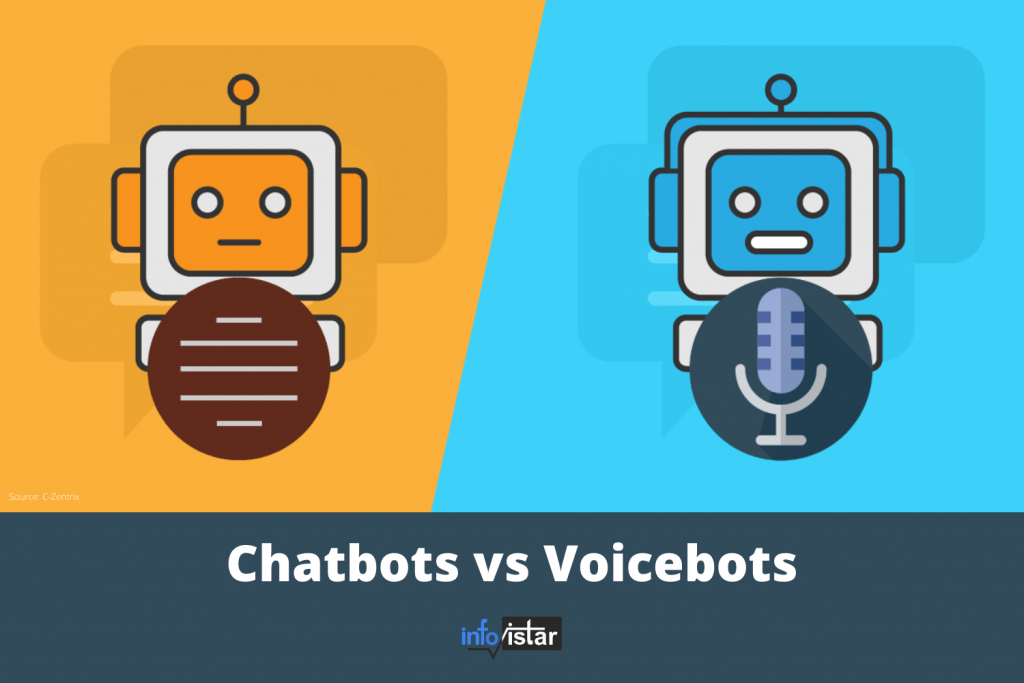In 2019, 25% of all customer interactions were automated by artificial intelligence or machine learning. By 2025, this number is expected to reach 50%. This clearly shows that more and more businesses see the value in automating parts of their customer service. However, they still have to choose which solution to choose – an AI chatbot or a voicebot.
In this article, we’ll explain the differences between chatbots and voice bots and when one might be preferred over the other.
What is a chatbot?
A chatbot is a type of software that communicates through a “conversational interface”. Most businesses use them as virtual customer service agents to relieve their employees from answering repetitive questions.

There are two types of chatbots available on the market
Rule-based chatbots
This type of chatbot is programmed to understand human inquiries based on regular expressions. Also known as ‘decision tree bots,’ as they have basic functionality. They don’t have learning abilities and can only understand what they’ve been directly trained to. In most cases, a rule-based chatbot will not be able to provide an answer if you ask the same question several ways.
Business requires much more powerful solutions, which is where AI chatbots truly excel.
AI chatbot
AI-based chatbots are more powerful than rule-based chatbots, as they are built to learn and improve over time. Unlike rule-based chatbots, they understand synonyms and read between the lines. If you provide a list of phrases, an AI chatbot can easily use them to learn another 20-30 words.

The AI-powered chatbots have become so sophisticated that 27% of respondents to a PwC survey couldn’t tell if they had spoken to a real agent or a chatbot. Rule-based chatbots are not capable of that!
Also read | Top 10 Best Chatbots for Small Businesses in 2022
What is a voicebot?
Voicebots are chatbots with voices. The software is based on artificial intelligence, enabling voice interactions with devices and services. Voicebots typically save users from navigating endless menus while on the phone.
Chatbot vs Voicebot
In some situations, voicebots might be preferable to chatbots. Take these factors into account when choosing the right bot.
Who are your customers and how do they interact with you
For starters, reach into your customer analytics tools or refer to your marketing persona. How old are your customers? Do they contact you through online channels, such as email or messaging apps? Do they prefer to communicate with your business through voice channels, such as phone calls?
These are the questions you should answer. This will help you determine whether your users are tech-savvy and spend a lot of time online. If they do, a chatbot might be more convenient – at least for basic question-and-answer interactions.
Consider your business niche
You should also consider the industry you are in and how many complex processes you must handle. Companies that provide insurance, banking, and healthcare might require customers to provide sensitive data before they can answer questions. People with well-founded fears of data leaks might be hesitant to submit details like ID numbers and credit card numbers in text form. Perhaps they would prefer a voicebot here.
How do you convey information?
One criterion to consider when choosing between a chatbot and a voicebot is the way information is transferred, as well as its volume. It can be conveyed in three ways:
- seeing – videos, images, and user interfaces
- hearing – voice interfaces like Alexa or Google Home
- reading – interfaces containing text.
The largest information volume can be processed by seeing. Hearing is next, followed by reading. If you want to communicate a lot of information quickly, pick a voicebot.
Alternatively, some people have short attention spans – as a result, they can’t retain the entire message unless it is in text format. It’s good to accommodate such users with a text-based chatbot in the interest of accessibility.
Also read | How AI Chatbots Are Changing the Future of Work
The type of information you’re processing
The types of information you can process include images, text, and audio. Voicebots only understand audio, whereas the chatbot can also process text, images, and videos. With a music platform like Spotify, you might be able to offer your users a voicebot to help them select songs while driving.
A chatbot would be more suitable for an e-commerce store since users can glance at multiple images and compare products. After covering all the criteria for choosing the right type of bot, the question remains “what is the best option?”.
The best option? Using both to cover all use cases/communication channels
There’s no reason to limit yourself to one option – you can use both a voicebot and a chatbot simultaneously. They can complement each other at different stages of the user journey, which will enable you to cover all the bases.
Infovistar offers a solution that incorporates both technologies

